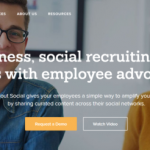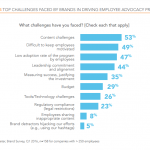KPIs For Measuring Employee Advocacy
April 20, 2016

What do you look for when measuring the effectiveness of your employee advocacy?
The current trend for the B2B industry is employee advocacy, and if you have not yet got on the band waggon, I would highly recommend it. The question here though is, what metrics should you put in place to measure its effectiveness? Yes, you can start by measuring post shares, retweets, and likes, but what are these in the scale of things? You should go a lot deeper than this.
Here are a few KPIs I would highly recommend you using to measure your programme’s effectiveness:
Number of employees signed up against number of active users
So you deploy employee advocacy into your brand, but how do you get employees initially on board, sharing content onto social media? Do you educate them with the benefits of sharing your content and explain what’s in it for them? And do you provide different levels of training to suit all capability levels? These are all a must.
You may think that this is not a problem because 30% of employees that signed up are posting. This is great, but unless employees see the benefit straight away they are likely to quickly lose interest. However with the right training at the start you can forewarn them on the realities of social media, for example that engagement will not happen overnight and why they should post additional content to improve their online personal presence. Without this employees will become disengaged and even stop posting your content.
Post engagement
By using a social media collaboration platform to post your content, reports can be easily generated to examine the number of likes, retweets, shares, as well as identify which employees are posting your content. By having access to these figures, you can then strategise as to the types of content, topics, and networks that works best for you, and use this as your benchmark when creating content in the future.
Website traffic
Using a program such as Google Analytics, can help identify if clicks have led to an increase in website traffic. It is however highly important to in particular look at the bounce rate. This is the percentage of visitors who leave your website from the landing page. This is an important metric, because the whole reason for sending individuals to your website is to encourage them to research other pages and engage with your brand further to hopefully sway their buying decision.
A bounce rate between 26% and 40% is excellent, but anything over 70% should sound alarm bells, this is extremely high and drastic action should be taken immediately to reduce this. If your bounce rate is high, is there really any point at all in employee advocacy? The answer is yes, as it will increase your reach but then what’s the point if it doesn’t lead to anything? This should be your first point of action.
Leads generated
This is a metric that has received a lot of questioning over the past year, with some suggesting that this is impossible to measure. You cannot just assume that a revenue increase is because of social selling. There could be a number of factors contributing to this.
One way that I suggest you measure this is via a social media collaboration platform and record all engagement within your CRM system, such as Salesforce. This way every post that receives engagement and leads to a sale can be tracked. This enables the brand to determine how effective social media is for generating sales, but it also enables the brand to make employees accountable for their social selling.
Brand reach
One of the fantastic things about social media is that it provides access to a much wider target audience, especially when you have an employee advocacy program in place. With this opportunity you should look to monitor whether an increase in employees sharing brand content correlates directly to you receiving engagement from a wider audience. This can all be monitored on a social media collaboration platform, and also through Google Analytics. That’s if, of course, they follow through and click on your link.
So, I’m sure you’ll agree there are numerous KPIs you could measure to test the effectiveness of your employee advocacy program, but in my opinion these are the ones you should be paying high attention to. And remember, employee advocacy will not be effective overnight, it takes time to build up; you need to be in it for the long run.
Digital & Social Articles on Business 2 Community
(8)













